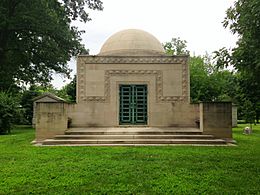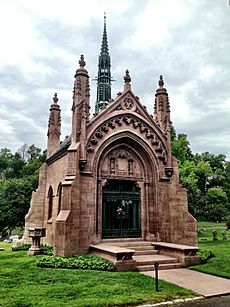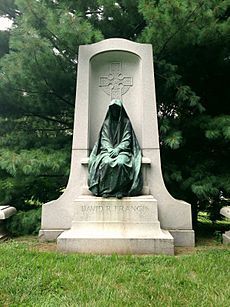Bellefontaine Cemetery facts for kids

The Wainwright Tomb at Bellefontaine Cemetery is listed on the National Register of Historic Places.
|
|
| Lua error in Module:Location_map at line 420: attempt to index field 'wikibase' (a nil value). | |
| Details | |
|---|---|
| Established | 1849 |
| Location |
4947 West Florissant Avenue
St. Louis, Missouri |
| Country | United States |
| Type | Public |
| Size | 314 acres (127 ha) |
| No. of graves | 87,000 |
Bellefontaine Cemetery is a special place in St. Louis, Missouri. It's a nonprofit cemetery, which means it's run for a good cause, not to make money. It's also non-denominational, welcoming people of all faiths.
Opened in 1849, Bellefontaine is also an arboretum, a place where many different kinds of trees and plants grow. It's known for its beautiful monuments and mausoleums, which are like small buildings where people are buried. One famous example is the Wainwright Tomb, designed by architect Louis Sullivan. This tomb is so important that it's listed on the National Register of Historic Places.
The cemetery covers about 314 acres (that's like 237 football fields!) and holds over 87,000 graves. Many famous people are buried here, including explorer William Clark, businessman Adolphus Busch, and politician Thomas Hart Benton. You'll also find many soldiers from both the Union and Confederate sides of the American Civil War here, along with many local and state politicians.
Discover Bellefontaine's Story
Why a New Cemetery Was Needed
In 1849, St. Louis was growing very fast. City leaders realized they needed a new cemetery outside the busy city center. The old graveyards were getting full and were thought to be a problem for city growth.
People also worried that bad air from city cemeteries could spread diseases. This concern became even stronger in the summer of 1849. A terrible cholera sickness swept through St. Louis, causing over 4,000 deaths. This event made it clear that a new, larger cemetery was urgently needed.
Creating a Peaceful Place
To solve this problem, a group of important St. Louis citizens formed the Rural Cemetery Association. They bought a large farm, about five miles northwest of the city. Their goal was to create a "rural cemetery," like the famous Père Lachaise Cemetery in Paris or Mount Auburn Cemetery in Massachusetts.
The farm was near a place called Fort Bellefontaine, so they named the new cemetery after it. They hired landscape architect Almerin Hotchkiss to design the grounds. Hotchkiss worked as the cemetery's superintendent for 46 years, designing its roads and beautiful landscapes. Over time, the cemetery grew to its current size of 314 acres.
First Burials and Growth
The first person was buried at Bellefontaine Cemetery on April 27, 1850. Soon after, bodies from older city graveyards were moved here. This included some from the cemetery near the Old Cathedral by the Mississippi River.
Bellefontaine also became the resting place for victims of the 1855 Gasconade Bridge train disaster. This was the worst train accident in Missouri's history. Many members of famous brewing families, like the Anheusers and Buschs, are also buried here.
In 1909, a new chapel was designed for the cemetery. Named the Hotchkiss Chapel, it was updated in 2009. It now includes a special room for urns, called a columbarium. The chapel is used for weddings and memorial services today.
Bellefontaine Cemetery Today
As of 2012, over 87,000 people have been buried at Bellefontaine Cemetery. About 100 new burials happen each year. It remains a non-profit and non-denominational cemetery.
The cemetery still has over 100 acres of open land. Some of this land has been turned into natural prairie and woodland areas. Bellefontaine has more than 14 miles of paved roads. As an accredited arboretum, it is home to over 180 different types of trees and shrubs.
Exploring the Grounds
The cemetery holds the graves of many important pioneers and leaders. The oldest graves belong to the family of pioneer Edward Hempstead, dating back to 1816. Many wealthy families have grand mausoleums here. These large, ornate tombs overlook the Mississippi River. They are built in various styles, like Classical, Romanesque, Gothic, and Egyptian.
Some of the most famous mausoleums include:
- The Wainwright Tomb, designed by Louis Sullivan in 1892.
- The Busch Mausoleum, designed for Adolphus and Lilly Busch in 1915.
- The Brown Brothers Mausoleums, designed in 1910 and 1928.
Many family plots are marked by tall obelisk monuments. You can take guided tours to see the cemetery's historical and architectural highlights. Self-guided tour brochures are also available at the cemetery office.
Bellefontaine Cemetery was added to the National Register of Historic Places in 2014.
Notable People Buried Here
Many interesting people are buried at Bellefontaine. Here are just a few:
Inventors, Explorers, and Business Leaders
- Adolphus Busch (1838–1913), who founded the famous Anheuser Busch Company.
- William Seward Burroughs (1857–1898), who invented an early mechanical calculator.
- William Clark (1770–1838), a famous explorer of the Louisiana Purchase territory.
- James Eads (1820–1887), an engineer who built bridges and ships.
- James Smith McDonnell (1899–1980), who founded the McDonnell Aircraft Corporation.
Politicians and Public Servants
- Edward Bates (1793–1869), who served as United States Attorney General under President Abraham Lincoln.
- Thomas Hart Benton (1782–1858), a U.S. Senator who supported westward expansion.
- Francis Preston Blair, Jr. (1821–1875), a Union Army general and politician during the Civil War.
- David R. Francis (1850–1927), a statesman who was governor of Missouri, mayor of St. Louis, and ambassador to Russia.
- Hamilton Rowan Gamble (1798–1864), who was the governor of Missouri during the Civil War.
- Stephen W. Kearny (1794–1848), a U.S. Army officer important in the Mexican–American War.
- Rush Limbaugh (1951–2021), a well-known radio show host.
- Sterling Price (1809–1867), a Confederate Army general and former governor of Missouri.
Educators and Activists
- John R. Anderson (minister) (1818–1863), a minister who fought against slavery and for education for African Americans.
- Mary Odilia Berger, S.S.M (1823–1880), who founded the Sisters of St. Mary, a group that established hospitals.
- Susan Blow (1843–1916), an educator known as the "Mother of Kindergarten."
- Phoebe Wilson Couzins (1842–1913), a pioneer for women's right to vote and one of the first female lawyers.
- William Greenleaf Eliot (1811–1887), a minister and civic leader.
- Virginia Minor (1824–1894), another important activist for women's suffrage.
Artists and Authors
- Sara Teasdale (1884–1933), a Pulitzer Prize-winning poet.
- Irma S. Rombauer (1877–1962), author of the famous cookbook The Joy of Cooking.
- Augustus Thomas (1857–1934), a well-known playwright.




